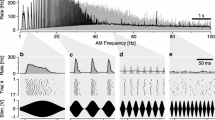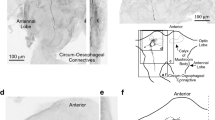Summary
-
1.
A new type of ascending interneurone (AN3) responding to airborne sound has been characterised morphologically and physiologically in the prothoracic ganglion of the cricketGryllus campestris (Fig. 1).
-
2.
The structure of AN3 is generally similar to that of two ascending neurons described previously (AN1, AN2).
-
3.
AN3 is highly tuned and very sensitive (threshold at CF, 30–35 dB SPL; Q10=3) to the calling song frequency. The tuning is enhanced by inhibitory sidebands on both the low and high frequency side (tuned to 3 kHz and 16 kHz respectively; Fig. 1).
-
4.
The other two AN types also show two-tone suppression effects which generally act so as to enhance the contrast of the response to the best frequency (Fig. 3–5). In contrast to AN3 and AN1, AN2 shows a great variability in its responses to low frequency sounds.
-
5.
AN3 and AN1 respond preferentially to the conspecific calling and aggression songs, supplementing each other in the intensity domain. AN2 responds only unspecifically to the calling and aggression songs but strongly to courtship syllables (Fig. 6).
-
6.
Stimulation with artificial song models reveals that the song specificity of AN3 and AN2 is due mainly to the frequency content of the songs. In AN2, an additional influence from the temporal structure becomes apparent (Fig. 6).
Similar content being viewed by others
Abbreviations
- CF :
-
carrier frequency
- CNS :
-
central nervous system
- CT :
-
control tone
- SNS :
-
simulated natural song
- TT :
-
test tone
References
Bacon JP, Altman JS (1977) A silver intensification method for cobalt-filled neurons in wholemount preparations. Brain Res 138:359–363
Boyan GS (1980) Auditory neurons in the brain of the cricketGryllus bimaculatus (DeGeer). J Comp Physiol 140:81–93
Boyan GS (1981) Two-tone suppression of an auditory neurone in the brain of the cricket: proposed role in phonotactic behaviour. J Comp Physiol 144:117–126
Davis NT (1982) Improved methods for cobalt filling and silver intensification of insect motor neurons. Stain Technol 57:239–244
Esch H, Huber F, Wohlers DW (1980) Primary auditory neurons in crickets: Physiology and central projections. J Comp Physiol 137:27–38
Hutchings ME, Lewis DB (1981) Response characteristics of primary auditory fibres in the cricketTeleogryllus oceanicus. J Comp Physiol 143:129–134
Hutchings M, Lewis B (1984) The role of two-tone suppression in song coding by ventral cord neurones in the cricketTeleogryllus oceanicus (Le Guillou). J Comp Physiol A 154:103–112
Kalmring K (1975) The afferent auditory pathway in the ventral cord ofLocusta migratoria (Acrididae) I. Synaptic connectivity and information processing among the auditory neurons of the ventral cord. J Comp Physiol 104:103–141
Kalmring K, Rehbein H-G, Kühne R (1979) An auditory giant neuron in the ventral cord ofDecticus verrucivorus (Tettigoniidae). J Comp Physiol 132:225–234
Kämper G, Dambach M (1981) Responses of the cercus-to-interneuron system in crickets to species-specific song. J Comp Physiol 141:311–317
Kühne R (1982) Neurophysiology of the vibration sense in locusts and bushcrickets: the response of ventral-cord neurones. J Insect Physiol 28:615–623
Nocke H (1972) Physiological aspects of sound communication in crickets (Gryllus campestris). J Comp Physiol 80:141–162
Popov AV, Markovich AM (1982) Auditory interneurones in the prothoracic ganglion of the cricket,Gryllus bimaculatus. II. A high frequency ascending neurone (HF1AN). J Comp Physiol 146:351–359
Rheinlaender J, Kalmring K, Popov AV, Rehbein H-G (1976) Brain projections and information processing of biologically significant sounds by two large ventral-cord neurons ofGryllus bimaculatus DeGeer (Orthoptera: Gryllidae). J Comp Physiol 110:251–269
Sachs MB, O'Connell NA (1983) Frequency analysis in the central nervous system of non-mammalian vertebrates. In: Lewis DB (ed) Bioacoustics. Academic Press, London, pp 283–310
Stout JF, Huber F (1981) Responses to features of the calling song by ascending auditory neurones in the cricketGryllus campestris L. Physiol Entomol 6:199–212
Wohlers DW, Huber F (1982) Processing of sound signals by six types of neurons in the prothoracic ganglion of the cricket,Gryllus campestris L. J Comp Physiol 146:161–173
Author information
Authors and Affiliations
Rights and permissions
About this article
Cite this article
Boyd, P., Kühne, R., Silver, S. et al. Two-tone suppression and song coding by ascending neurones in the cricketGryllus campestris L.. J. Comp. Physiol. 154, 423–430 (1984). https://doi.org/10.1007/BF00605241
Accepted:
Issue Date:
DOI: https://doi.org/10.1007/BF00605241




